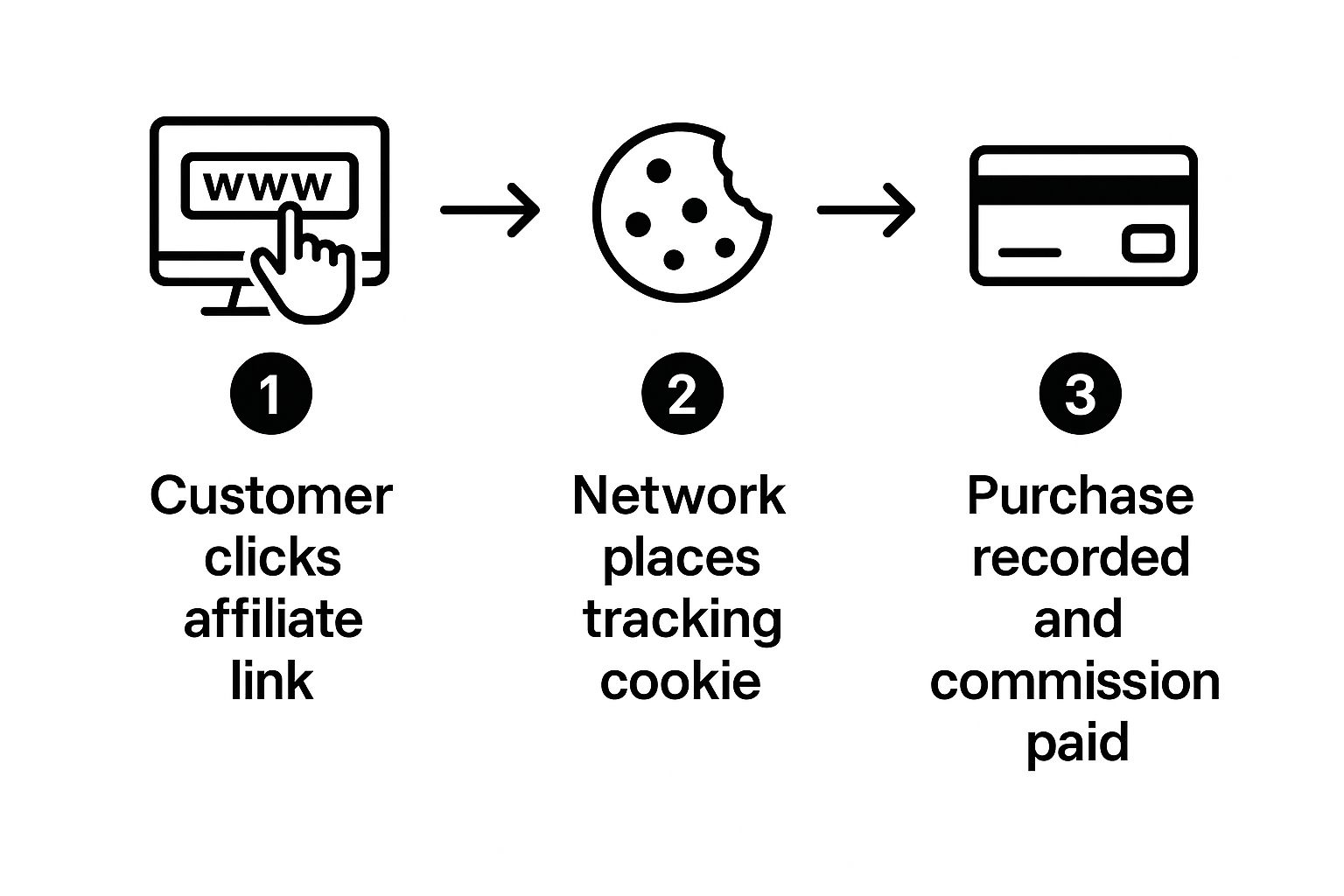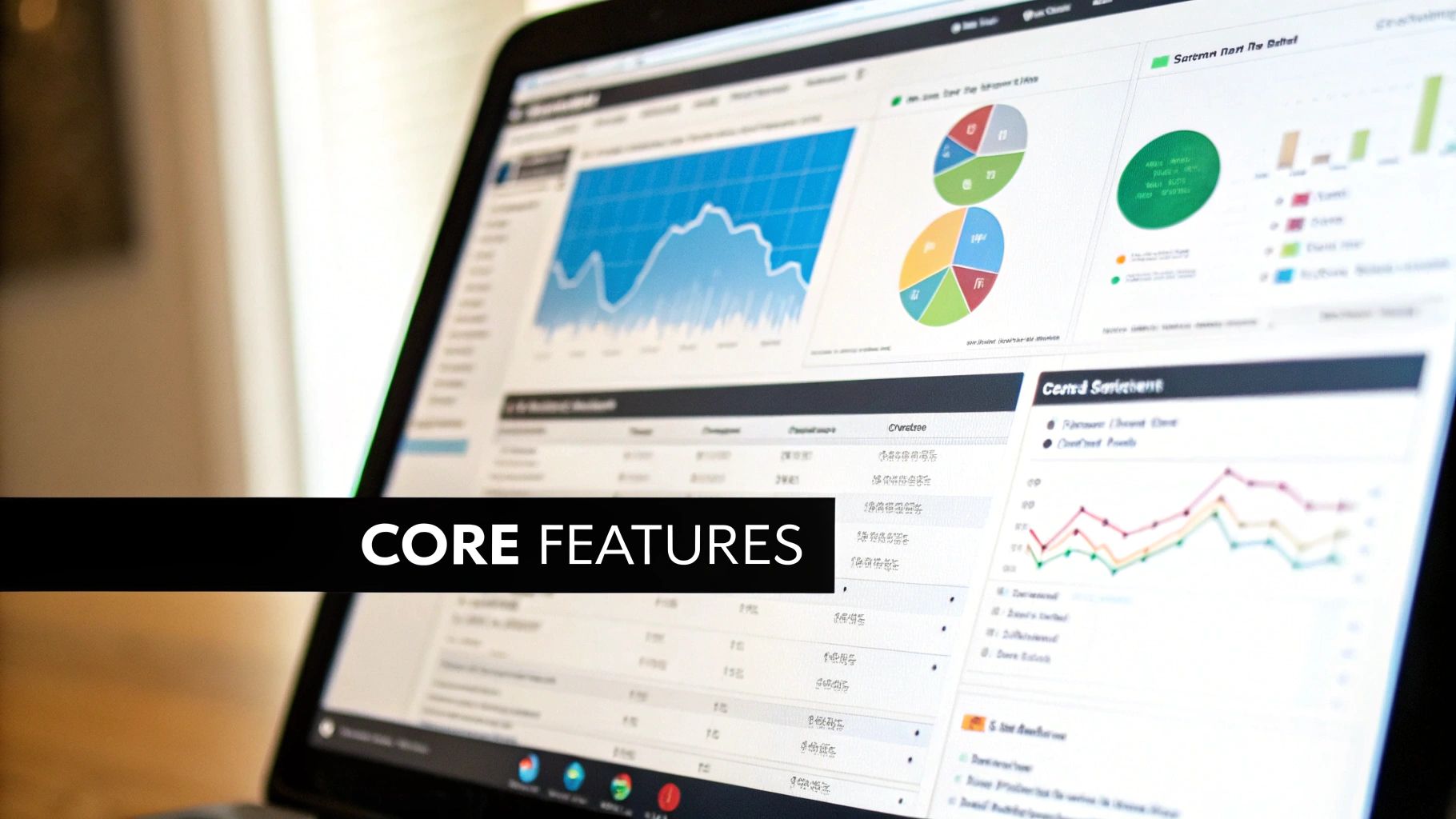Think of an affiliate network as the ultimate digital marketplace. It's a bustling hub where businesses with great products (we call them merchants) can find skilled marketers (affiliates) who are ready and willing to promote them. In a nutshell, the affiliate network is the essential middleman that makes these powerful partnerships happen.
The Role of an Affiliate Network in Digital Marketing

At its heart, an affiliate network is a trusted intermediary. It simplifies the entire affiliate marketing process, taking the logistical headache away from both merchants and affiliates. Imagine a brand trying to find, screen, and manage hundreds of individual marketers on their own—it would be a nightmare. The network provides the platform to make these connections happen efficiently. It’s the digital matchmaker for performance marketing.
This structure gets rid of so much of the administrative grunt work. The network handles all the critical technical details, including:
- Tracking: Precisely monitoring every click, conversion, and sale that an affiliate sends over.
- Payments: Handling all the commission payouts, making sure every affiliate gets paid accurately and on time.
- Reporting: Giving both merchants and affiliates clear dashboards and analytics to see what's working and what isn't.
- Dispute Resolution: Acting as a neutral third party to sort out any disagreements and keep things fair.
Key Players in the Ecosystem
To really get how an affiliate network operates, it helps to break down who's involved. Each player has a specific role, and they all work together in a system where everyone benefits when things go well. The whole ecosystem is built on shared goals.
The table below gives a clear snapshot of each participant and what they bring to the partnership.
Key Players in an Affiliate Network Ecosystem
| Participant | Primary Role | Main Objective |
|---|---|---|
| The Merchant | The business selling a product or service. | To grow sales and brand awareness with a performance-based marketing team. |
| The Affiliate | The marketer, content creator, or influencer promoting the product. | To earn a commission by sending qualified traffic and sales to the merchant. |
| The Customer | The person who buys something via an affiliate link. | To discover helpful products based on recommendations they trust. |
| The Network | The platform that connects merchants and affiliates. | To make partnerships easy, manage all tracking, and keep operations running smoothly. |
By bringing all these functions under one roof, the network creates a secure and organized environment. Merchants can tap into a huge pool of vetted marketing talent, and affiliates get access to thousands of products to promote without having to negotiate separate deals with every single company. It’s a model built for efficiency and scale.
How Affiliate Networks Actually Work
The best way to really get what an affiliate network does is to follow the money, or in this case, the click. Let's walk through a common scenario.
Imagine someone is reading a blog post reviewing a new software tool. The review is compelling, and they decide they want to try the product for themselves.
They click on a link in the article—what's known as an affiliate link. This is where the magic happens. That click instantly kicks the network's technology into gear. This isn't just a regular link; it's a unique URL that the network gives to the blogger (the affiliate) to track their specific referrals.
That simple click triggers a critical background process. The network places a tiny tracking file, better known as a cookie, on the reader's browser. This cookie is like a digital breadcrumb, holding all the information needed to identify the blogger as the one who sent the customer over. It’s a virtual name tag that makes sure the right person gets the credit.
From Click to Commission
Once that cookie is set, it stays on the person's browser for a specific amount of time, known as the "cookie window." This could be just 24 hours or as long as 90 days (or even more), all depending on the rules the merchant sets.
If the customer buys anything from the merchant's site while that cookie is still active, the network's system spots it.
This is how the network automatically connects the sale back to the blogger who sent them there. The whole thing happens behind the scenes, ensuring every single referral is tracked and logged without a single manual entry. The system then automatically calculates the blogger's commission based on the percentage they agreed on.
This infographic lays out the simple three-step journey from that first click to the final payout.

As you can see, the network acts as the automated middleman, linking a customer's purchase directly to an affiliate's reward. It completely removes the need for manual tracking or verification.
The Final Step: Payout and Reporting
After a sale is tracked, the commission pops up in the affiliate's dashboard on the network's platform. Merchants usually have a waiting period to make sure the sale is legitimate and to account for any returns. Once that time passes, the commission gets approved.
The network then bundles up all the approved commissions an affiliate has earned—often from many different merchants—and sends them one consolidated payment. It’s this streamlined process that makes affiliate marketing such a dependable and scalable way to earn an income.
Key Takeaway: At its heart, an affiliate network's main job is to provide unbiased, third-party tracking and attribution. It’s the glue that holds the system together, making sure affiliates are paid fairly for every sale they generate and building a foundation of trust for everyone involved.
If you're curious about the nuts and bolts, we've got a deep dive on how to track affiliate links that really gets into the mechanics. Understanding this process is key to seeing why this performance-based model works so well.
The Core Components of a Modern Affiliate Network

Think of an affiliate network not just as a marketplace, but as a sophisticated digital workshop. It’s equipped with specialized tools that merchants and affiliates both rely on to build profitable partnerships. Each tool has a specific job, and together, they make the entire system run like a well-oiled machine.
For merchants, their command center is the merchant dashboard. This is where they bring their program to life—uploading products, creating promotional materials like banners and ad copy, and defining the rules of engagement.
Affiliates get their own space, the affiliate portal. This is their gateway to opportunity, a place to browse products, discover new brands to promote, and grab the unique tracking links that ensure they get paid for their efforts.
The Technology Powering Partnerships
At the core of every affiliate network is the tracking and attribution engine. This is the unsung hero of the entire operation. It’s the smart tech that meticulously follows a customer's path from an affiliate's blog post or social media link all the way to a sale, making sure the right person gets credit. Without this, the trust that holds everything together would simply vanish.
Backing up the tracking engine is a powerful reporting and analytics suite. This is where the numbers tell the story. Affiliates can see exactly which campaigns are clicking with their audience, and merchants get a clear view of who their top-performing partners are.
This focus on clear, measurable results is a huge reason why the global affiliate marketing industry is valued at over $18.5 billion as of 2024. With more than 80% of advertisers now running affiliate programs, these networks provide the essential framework to manage it all at scale.
Managing a Successful Program
Beyond the tracking and analytics, networks handle the practical, day-to-day management that keeps a program healthy. The commission and payment system is a huge piece of this puzzle. It automates the often-tricky process of calculating who earned what and ensures affiliates get paid correctly and on schedule—a non-negotiable for building lasting relationships.
You can actually find a wide variety of ways to structure these payouts. Check out some common commission structure examples to see just how flexible they can be.
Finally, a network isn’t just software; it’s a community built on a shared set of rules. Clear guidelines and legal frameworks, like detailed Affiliate Terms, create a fair and predictable environment. When all these components work together, they form a dependable ecosystem where performance-based marketing can truly flourish.
Why Not Just Go Direct? The Strategic Edge of Affiliate Networks
So, why don't businesses and marketers just connect directly? It’s a fair question. The answer comes down to the unique and powerful advantages an affiliate network brings to the table for both sides. Think of it like trying to navigate a sprawling, unfamiliar city. You could try to do it with just a paper map, or you could hire an expert local guide who knows all the shortcuts, hidden gems, and best routes.
An affiliate network is that expert guide. It streamlines the entire process, turning potential chaos into a smooth, efficient operation.
For merchants, joining a network is like instantly onboarding a dedicated, performance-based sales force. Instead of pouring money into upfront advertising campaigns with no guarantee of a return, they only pay when a specific action happens—usually a sale. This pay-for-performance model takes a massive amount of financial risk off the table while unlocking incredible reach.
For affiliates, the benefits are just as powerful. A network is their gateway to a huge, pre-vetted catalog of products and services. Forget the hassle of hunting down individual brands and trying to negotiate separate deals. They get immediate access to thousands of potential partners, all in one place.
The Merchant Advantage: Scalable, Low-Risk Growth
For any business, the network model is a strategic engine for growth. It clears away the administrative hurdles and opens the door to new, predictable revenue streams.
- Massive Reach: Instantly tap into a diverse pool of thousands of motivated marketers, from niche bloggers to major publications.
- Low-Risk Growth: Pay only for results. This performance-based model means your marketing spend is directly tied to the revenue it generates.
- Simplified Management: A single platform handles all the tracking, reporting, and payments for hundreds or even thousands of partners. The time savings alone are immense.
The Affiliate Advantage: Opportunity and Efficiency
For content creators and marketers, networks provide the structure and tools they need to turn their influence into a reliable income stream.
- Access to Top Brands: Discover and partner with reputable companies and high-converting products in a centralized, easy-to-use marketplace.
- Consolidated Payments: Get one single, reliable payment for all commissions earned across multiple merchants. No more chasing down individual invoices.
- Powerful Tools: Get access to advanced tracking links, detailed analytics, and ready-made promotional materials to fine-tune your campaigns for better results. For instance, many affiliates learn how to monetize an Instagram account through affiliate marketing as a core part of their strategy, and networks provide the tools to make that happen.
This streamlined environment is a huge reason the affiliate marketing industry keeps growing so quickly. It's projected that by 2025, over 81% of brands will have an affiliate program, proving just how effective the model is. The ROI is a major driver, with brands often seeing an average return of $15 for every $1 spent on affiliate marketing. That figure really underscores how cost-effective a well-run program can be.
Affiliate Network vs Direct Partnerships
To really see the difference, it helps to compare the two approaches side-by-side. While direct partnerships can work for businesses with very specific needs, the network model offers a level of scale and simplicity that’s hard to beat.
| Feature | Using an Affiliate Network | Managing Direct Partnerships |
|---|---|---|
| Partner Discovery | Access to thousands of pre-vetted affiliates in a marketplace. | Manual outreach and recruitment is time-consuming and difficult. |
| Setup & Technology | All tracking, reporting, and links are handled by the platform. | Requires building or buying expensive tracking software in-house. |
| Payments & Invoicing | Handles all payouts to affiliates with a single, simple process. | Merchants must manage individual invoices and payments for each partner. |
| Trust & Security | Acts as a trusted third party, handling disputes and fraud. | All risk and dispute resolution falls on the merchant and affiliate. |
| Time Investment | Significantly lower administrative overhead for both parties. | High time commitment for recruitment, management, and payments. |
Ultimately, a network acts as a trusted third party that builds a foundation of security, efficiency, and scale. It replaces administrative chaos with organized opportunity, creating a space where both merchants and affiliates can focus on what they do best: selling great products and creating valuable content.
Choosing the Right Affiliate Network for Your Goals

Picking an affiliate network is one of those make-or-break decisions, whether you're a business with a product to sell or a creator looking to monetize your content. The truth is, not all networks are built the same. The one that’s a home run for a B2B software company could be a total miss for a lifestyle blogger.
The right choice comes down to looking past the flashy marketing and getting into the nitty-gritty of what actually matters for you. You’re not just signing up for a service; you're building a partnership. And just like any good partnership, you need to be aligned on goals, values, and how you operate.
Evaluate the Network’s Reputation and Niche Focus
First things first: do your homework on the network's reputation in your specific corner of the market. Do they live and breathe physical products, or is their sweet spot digital downloads and SaaS subscriptions? A network that already specializes in your niche is a huge leg up—it means they’ll have a ready-made pool of merchants and affiliates who get your audience.
Scour the web for real user reviews and case studies on sites that aren't owned by the network itself. What are people actually saying? Zero in on comments about payment reliability, how responsive their support team is, and the quality of their platform tools. A little digging here can save you from partnering with a network known for late payments or ghosting its users.
Key Insight: A network's specialization isn't just a feature; it's a strategic advantage. A focused network gets the unique challenges of your industry and offers more relevant partners and better-informed support than a generic, one-size-fits-all platform ever could.
Assess the Quality of Partners and Products
Once a network passes the reputation check, it's time to peek under the hood and see who's already there.
For Merchants: Take a hard look at the affiliates. Are you seeing established content creators and influencers who your customers trust? Or does it look like a sea of low-effort coupon and cashback sites? The quality of affiliates will directly reflect on your brand.
For Affiliates: Sift through the merchant directory. Are these products you’d be proud to recommend? Promoting junk can tank the credibility you’ve worked so hard to build with your audience.
At the end of the day, the people and products on a network determine your ceiling for success. A crucial part of this is ensuring the tech is solid, too. Reliable tracking is non-negotiable. Many businesses use dedicated platforms for this, and you can find great breakdowns of the best affiliate tracking software to understand which features are most important. Getting this right from the start prevents a world of frustration down the road.
How Refgrow Elevates Your Affiliate Marketing
Knowing how affiliate networks work is one thing, but finding a platform that actually fits how modern businesses operate is a completely different challenge. So many traditional networks feel clunky, over-complicated, and totally disconnected from your actual product. We built Refgrow to solve those exact problems, creating a far more intuitive and integrated experience for you and your partners.
Instead of forcing you and your affiliates onto some outdated, external dashboard, we give you a clean, embeddable system that lives right inside your own SaaS application. This simple shift removes all the usual friction. It makes your partner program feel like a natural extension of your product, not some clunky tool you bolted on the side.
Seamless Integration and Precision Tracking
At its core, Refgrow is all about making powerful features simple to use. We zeroed in on the biggest headaches that growing businesses face when trying to get a real partner program off the ground and scale it effectively.
- Effortless Setup: You can get a fully native and customizable affiliate dashboard running inside your app with just one line of code. No joke.
- Precision Analytics: We deliver clear, insightful data that helps both you and your affiliates make smarter decisions. It's about moving past vanity metrics and focusing on what actually drives growth.
- Transparent Environment: Our reliable tracking and straightforward reporting build trust between you and your partners. When everyone is on the same page, the partnership just works better.
Refgrow turns affiliate marketing from a complex management chore into a streamlined growth engine. Our goal is to give you the tools to build a transparent, effective, and scalable program without all the typical headaches.
By solving these common frustrations, we make it possible for you to launch, manage, and grow your partnerships without getting bogged down in the process.
Common Questions About Affiliate Networks
Even after you get the basic idea, a few questions always seem to come up when you're first digging into affiliate networks. Let's tackle some of the most common ones so you can move forward with confidence.
Can I Join an Affiliate Network for Free?
For affiliates—the publishers, bloggers, and content creators—the answer is almost always yes. Joining a network should be completely free. The network earns its keep by taking a small cut from the merchant's side after you've successfully made a sale. If a platform ever asks you, as an affiliate, to pay just to join, that's a major red flag.
For merchants, though, it's a different story. You can expect to see costs like an initial setup fee, recurring monthly platform fees, and of course, the network's commission (often called an override) that gets added on top of what you pay your affiliates. These fees cover the technology, the managed services, and access to that all-important pool of vetted publishers.
Do I Need a Website to Become an Affiliate?
Not anymore. While having a blog or a niche website is still a classic and very effective way to do affiliate marketing, it's definitely not the only game in town. Plenty of affiliates are crushing it without ever owning a traditional website.
Key Takeaway: The modern affiliate landscape is incredibly diverse. Success isn't about the type of platform you have; it's about whether you have an engaged audience, wherever they hang out online.
Many successful affiliates focus entirely on channels like:
- Social Media: Think influencers on Instagram, TikTok, and YouTube who seamlessly weave product recommendations into their content.
- Email Newsletters: A loyal email list is a goldmine. You can send targeted affiliate offers directly to an audience that already trusts you.
- Paid Advertising: Some affiliates are experts at running paid campaigns on Google or Facebook, sending traffic straight to the merchant's landing page.
What is the Difference Between an Affiliate Network and an Affiliate Program?
This is probably the most important distinction to understand. An in-house affiliate program is run directly by a single company to promote its own products and services. That's it. An affiliate network, on the other hand, is a massive marketplace that brings together programs from hundreds or even thousands of different companies.
Here’s a simple analogy: an in-house program is like a brand's own standalone store. A network is like a giant shopping mall that houses all those different stores under one roof. Both have their place, but a network gives you far more variety, simplified payments, and one central place to manage everything.
Ready to build an affiliate program that feels like a natural part of your product? Refgrow offers a seamless, embeddable dashboard that you can set up with just one line of code. Start growing your partnerships today!

